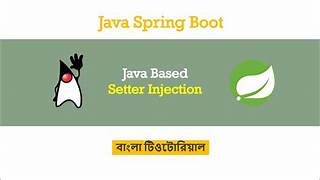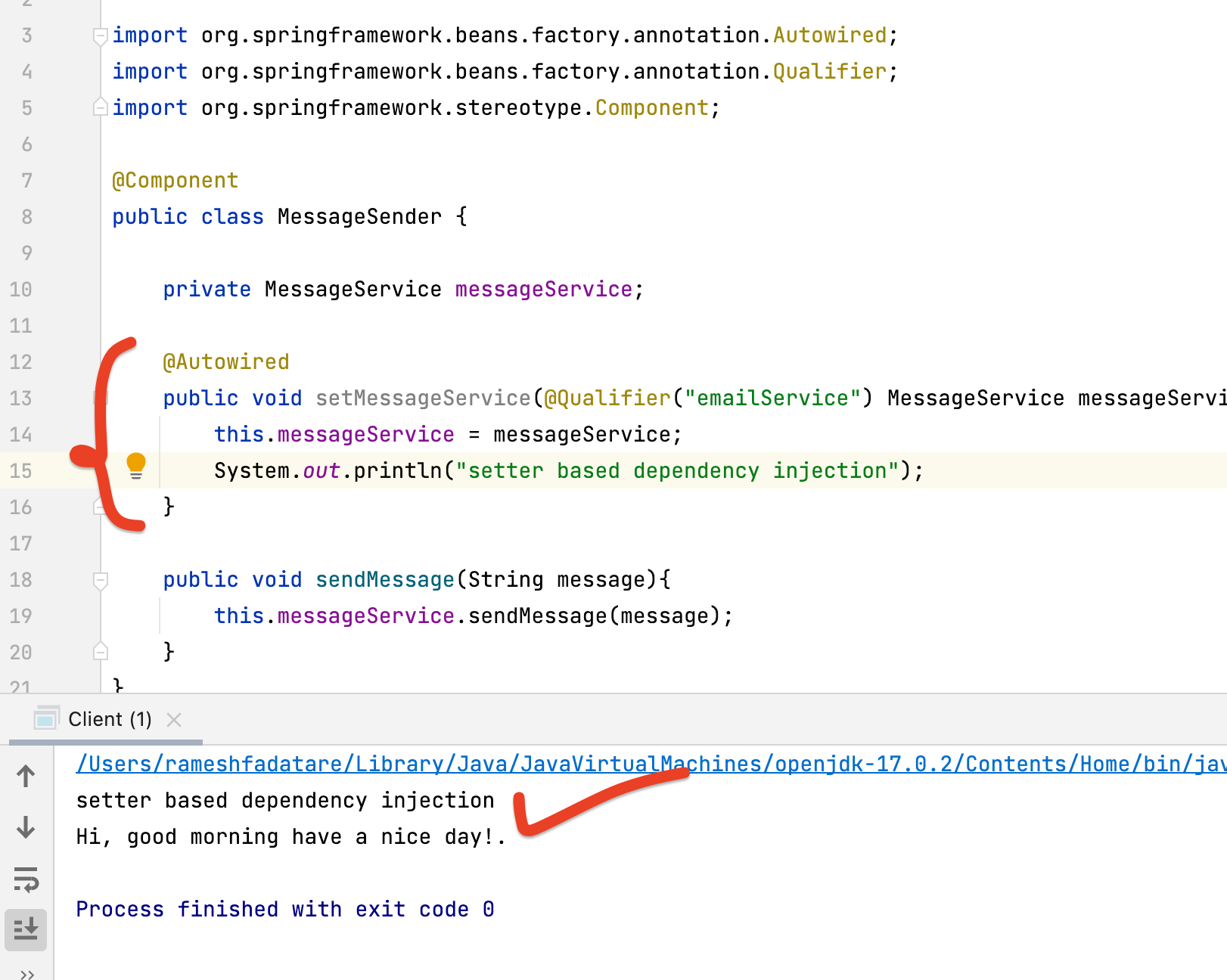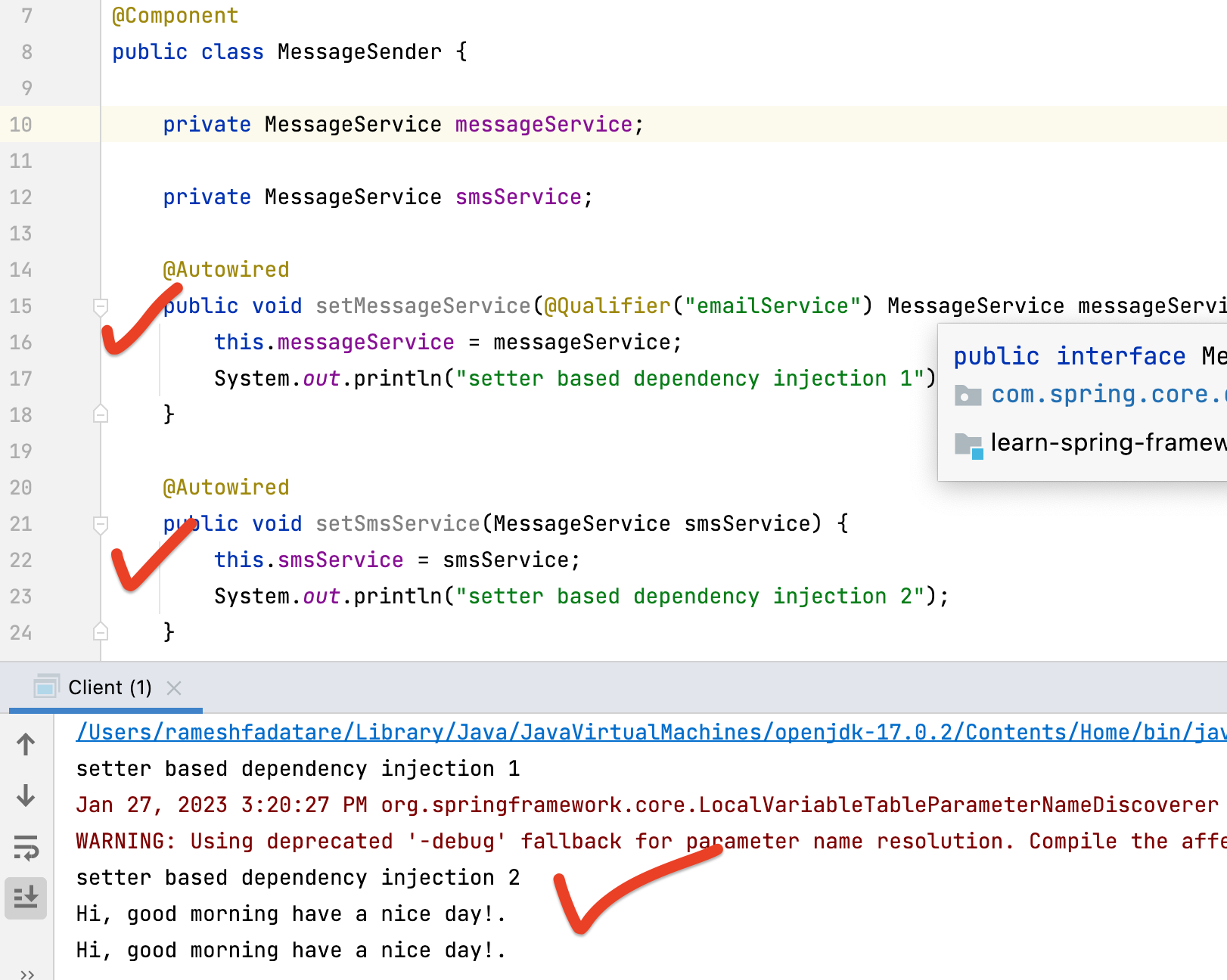

In this tutorial, we will learn how to use setter-based dependency injection in the Spring boot
application.
Dependency Injection is a design pattern on which dependency of the object is injected by the framework
rather than created by the Object itself - It is also called IOC (Inversion of Control).
Dependency Injection reduces coupling between multiple objects as its dynamically injected by the
framework.
There are mainly three types of Dependency Injection:
In this tutorial, we will see step by step how to use setter-based dependency injection in the Spring boot application.
Setter injection uses the setter method to inject dependency on any Spring-managed bean.
Well, the Spring IOC container uses a setter method to inject dependency on any Spring-managed bean.
We have to annotate the setter method with the @Autowired annotation.
In order to demonstrate the usage of setter injection, let's create a few interfaces and classes.
public interface MessageService {
void sendMessage(String message);
}
import org.springframework.stereotype.Component;
@Component
public class EmailService implements MessageService{
@Override
public void sendMessage(String message){
System.out.println(message);
}
}We have annotated EmailService class with @Component annotation so the Spring container automatically creates a Spring bean and manages its life cycle.
import org.springframework.stereotype.Component;
@Component("smsService")
public class SMSService implements MessageService{
@Override
public void sendMessage(String message){
System.out.println(message);
}
} We have annotated SMSService class with @Component annotation so the Spring container automatically creates a Spring bean and manages its life cycle.
import org.springframework.beans.factory.annotation.Autowired;
import org.springframework.beans.factory.annotation.Qualifier;
import org.springframework.stereotype.Component;
@Component
public class MessageSender {
private MessageService messageService;
@Autowired
public void setMessageService(@Qualifier("emailService") MessageService messageService) {
this.messageService = messageService;
System.out.println("setter based dependency injection");
}
public void sendMessage(String message){
this.messageService.sendMessage(message);
}
}@Qualifier annotation is used in conjunction with Autowired to avoid confusion when we have two or
more beans configured for the same type.
Spring container uses the below setter method to inject dependency on any Spring-managed bean (MessageSender
is a Spring bean):
@Autowired
public void setMessageService(@Qualifier("emailService") MessageService messageService) {
this.messageService = messageService;
System.out.println("setter based dependency injection");
}
import org.springframework.context.annotation.ComponentScan;
import org.springframework.context.annotation.Configuration;
@Configuration
@ComponentScan(basePackages = "com.spring.core.di")
public class AppConfig {
}@Configuration: Used to indicate that a configuration class declares one or more @Bean methods. These
classes are processed by the Spring container to generate bean definitions and service requests for those
beans at runtime.
s
@ComponentScan: This annotation is used to specify the base packages to scan for spring
beans/components.
import org.springframework.context.ApplicationContext;
import org.springframework.context.annotation.AnnotationConfigApplicationContext;
public class Client {
public static void main(String[] args) {
String message = "Hi, good morning have a nice day!.";
ApplicationContext applicationContext = new AnnotationConfigApplicationContext(AppConfig.class);
MessageSender messageSender = applicationContext.getBean(MessageSender.class);
messageSender.sendMessage(message);
}
}
Let's see how to inject multiple dependencies using Setter injection.
To inject multiple dependencies, we have to create multiple fields and their respective setter
methods.
In the below example, the MessageSender class has multiple setter methods to inject multiple dependencies
using setter injection:
import org.springframework.beans.factory.annotation.Autowired;
import org.springframework.beans.factory.annotation.Qualifier;
import org.springframework.stereotype.Component;
@Component
public class MessageSender {
private MessageService messageService;
private MessageService smsService;
@Autowired
public void setMessageService(@Qualifier("emailService") MessageService messageService) {
this.messageService = messageService;
System.out.println("setter based dependency injection 1");
}
@Autowired
public void setSmsService(MessageService smsService) {
this.smsService = smsService;
System.out.println("setter based dependency injection 2");
}
public void sendMessage(String message){
this.messageService.sendMessage(message);
this.smsService.sendMessage(message);
}
}
In this tutorial, we saw how to use setter-based dependency injection in the Spring boot application. Also,
check out Spring Boot Constructor Injection Example
Check out all the Spring boot tutorials and guides at 500+ Spring Boot Tutorials